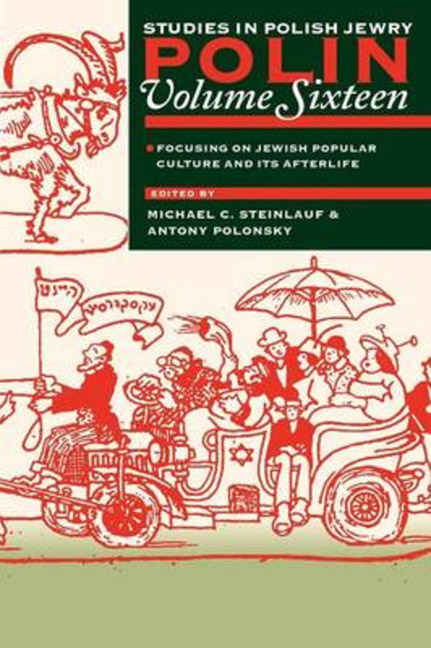Book contents
- Frontmatter
- Dedication
- Editors and Advisers
- Preface
- Polin
- Polin: Studies in Polish Jewry
- Contents
- Note on Place Names
- Note on Transliteration
- PART I JEWISH POPULAR CULTURE IN POLAND AND ITS AFTERLIFE
- IN PRE-WAR POLAND
- The Badkhn: From Wedding Stage to Writing Desk
- Remembrance of Things Past: Klezmer Musicians of Galicia, 1870–1940
- Early Recordings of Jewish Music in Poland
- Jewish Theatre in Poland
- A Tuml in the Shtetl: Khayim Betsalel Grinberg's Di khevre-kedishe sude
- Mordechai Gebirtig: The Folk Song and the Cabaret Song
- Simkhe Plakhte: From ‘Folklore’ to Literary Artefact
- Between Poland and Germany: Jewish Religious Practices in Illustrated Postcards of the Early Twentieth Century
- Papers for the Folk: Jewish Nationalism and the Birth of the Yiddish Press in Galicia
- Shund and the Tabloids: Jewish Popular Reading in Inter-War Poland
- Dos yidishe bukh alarmirt! Towards the History of Yiddish Reading in Inter-War Poland
- Exploiting Tradition: Religious Iconography in Cartoons of the Polish Yiddish Press
- AFTERLIFE
- PART II DOCUMENTS
- PART III NEW VIEWS
- PART IV REVIEWS
- REVIEW ESSAYS
- BOOK REVIEWS
- CORRESPONDENCE
- OBITUARIES
- Notes on the Contributors
- Glossary
- Index
Mordechai Gebirtig: The Folk Song and the Cabaret Song
from IN PRE-WAR POLAND
- Frontmatter
- Dedication
- Editors and Advisers
- Preface
- Polin
- Polin: Studies in Polish Jewry
- Contents
- Note on Place Names
- Note on Transliteration
- PART I JEWISH POPULAR CULTURE IN POLAND AND ITS AFTERLIFE
- IN PRE-WAR POLAND
- The Badkhn: From Wedding Stage to Writing Desk
- Remembrance of Things Past: Klezmer Musicians of Galicia, 1870–1940
- Early Recordings of Jewish Music in Poland
- Jewish Theatre in Poland
- A Tuml in the Shtetl: Khayim Betsalel Grinberg's Di khevre-kedishe sude
- Mordechai Gebirtig: The Folk Song and the Cabaret Song
- Simkhe Plakhte: From ‘Folklore’ to Literary Artefact
- Between Poland and Germany: Jewish Religious Practices in Illustrated Postcards of the Early Twentieth Century
- Papers for the Folk: Jewish Nationalism and the Birth of the Yiddish Press in Galicia
- Shund and the Tabloids: Jewish Popular Reading in Inter-War Poland
- Dos yidishe bukh alarmirt! Towards the History of Yiddish Reading in Inter-War Poland
- Exploiting Tradition: Religious Iconography in Cartoons of the Polish Yiddish Press
- AFTERLIFE
- PART II DOCUMENTS
- PART III NEW VIEWS
- PART IV REVIEWS
- REVIEW ESSAYS
- BOOK REVIEWS
- CORRESPONDENCE
- OBITUARIES
- Notes on the Contributors
- Glossary
- Index
Summary
WHEN does a song become a ‘folk’ song? Certainly not when it is written down, and not when it has only been sung for the first time. Only when it has been repeated once, twice, or three times—when it catches on and moves from the stage to the kitchen and its composer is forgotten. But even then it must survive the test of time. Scholars say it takes at least two generations.
A song's career can start on any stage, even an amateur one, and it need not be sung by a professional singer. But beginning on the professional stage, in an operetta or literary cabaret, gives a song a better chance. When first heard in cabaret or in the movies, it may become a hit, popular throughout a country or even throughout the world. Yet a hit song is not a folk song. Its popularity passes; it gives way to new fashions. Old people may still recall it with nostalgia, but it says nothing to new generations. It is different with a folk song, which enters the repository of national folklore and remains there. It becomes a part of folk culture, while its author remains anonymous or is known only to specialists.
Mordechai Gebirtig (1877–1942) engraved his name on the history of Jewish cabaret in Poland between the wars. Every singer had his songs in his or her repertoire. These songs spread from the cabaret stages (kleynkunstbine) of Łódź and Warsaw to all of Poland and to the entire Jewish world. Even today they are alive on the stage and in Jewish homes; they are an indispensable part of the repertoire of Jewish singers. They are also arousing increasing interest among non-Jewish audiences in Poland, Germany, the Netherlands, Italy, and the United States. Since the destruction of European Jewry these songs have become a crucial means of learning about Jewish folklore and the life of the Jewish poor, matters inadequately recorded in Yiddish literature and other sources.
Mordechai Gebirtig (né Bertig) was born on 4 May 1877 in Kazimierz, Kraków's Jewish quarter. After a few years of traditional instruction in a kheyder his father apprenticed him to a carpenter. Gebirtig spent his youth among workers, and this environment shaped his political views, as he came under the influence of social democratic parties.
- Type
- Chapter
- Information
- Focusing on Jewish Popular Culture and Its Afterlife , pp. 107 - 118Publisher: Liverpool University PressPrint publication year: 2003

